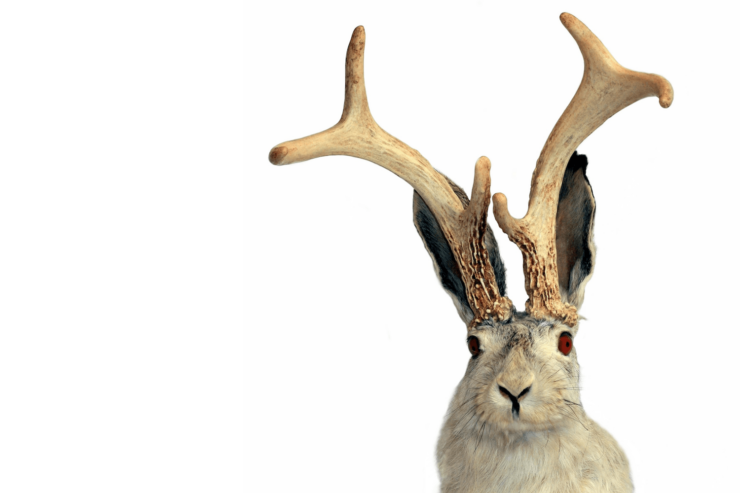Cryptids are, by definition, creatures that dwell beyond the threshold of conventional science. People who hunt them and profess to study them live in hope that their chosen quarry will somehow, someday, produce incontrovertible evidence of its existence. Cryptozoology, by its nature, relies on the power of faith.
Many cryptids seem to resolve into misidentifications of known species. Some appear to be memories of extinct animals. Others may turn out to be known animals living far outside of their usual range. Once in a great while, one may actually be found, with great and appropriate fanfare.
And then there are the creatures of folklore. Tall tales. Whoppers and leg-pullers designed to catch the gullible and raise a good laugh at the local watering hole.
Humans do love their stories. They also love to pull pranks. Hoaxes are an ancient art and craft. P.T. Barnum exhibited the Feejee Mermaid as “proof” that the mythical sea creature actually exists. (It was the top half of a monkey sewn onto the bottom half of a fish.)
Maybe that was part of the inspiration for the notorious and persistent tale of the jackalope. This North American classic purports to be a cross between a pygmy deer and a jackrabbit. It’s quite straightforward: a jackrabbit with antlers.
Images of it show up all over the continent, particularly in the mountain West. According to the lore, it’s vanishingly rare; it only mates during electrical storms. It has superpowers: for example, it can catch bullets in its teeth. And it can sing. Just ask a cowboy who has harmonized with it around a campfire.
It’s a joyous hoax, a myth with a wink. Apparently it originated in Douglas, Wyoming in 1934, when taxidermist Ralph Herrick and his brother Doug attached a set of deer antlers to the preserved carcass of a jackrabbit.
What started as a couple of guys having some fun on the job turned into a huge thing. The brothers founded a cottage industry, turning out whole lines of taxidermied jackalopes. The town of Douglas embraced it; it became their signature attraction. To this day, they’re issuing jackalope hunting licenses by the thousands, and jackalope postcards are a staple of roadside rest stops all across the West. Eventually, the whole of Wyoming embraced it, and it’s become a symbol of the state.
That’s not all there is to the story. It turns out the jackalope is not entirely, or exactly, mythical. There is a disease that afflicts rabbits, that causes hard, hornlike growths on their heads. It’s called the Shope papilloma virus, and it’s a real thing. There’s even a specimen in the Smithsonian.
The same can’t be said of one of my favorite cryptic cryptids, the mighty Squonk. This is the diametrical opposite of the Jackalope for looks and personality. It’s an older tale, concocted, it’s said, in the nineteenth century and recorded in a Very Serious Tome published in 1910, William T. Cox’s Fearsome Creatures of the Lumberwoods, With a Few Desert and Mountain Beasts—because what’s a Very Serious Tome without a Rather Long and Compendious Title?
The Squonk, according to Mr. Cox, was once widely dispersed throughout the continent, but its range has shrunk to the hemlock forests of northern Pennsylvania, in and around the Poconos. It’s fearfully ugly, piglike in shape and size, with a loose, wrinkled, warty skin. It spends its life in hiding, weeping over its own ugliness.
Hunters, we’re told, have managed to capture it, but once confined, it melts into a puddle of tears. Which is one way to explain why there’s no physical evidence. Stuff it into a bag and all you’re left with is a damp spot and a sense of the futility of it all.
That’s magnificent in its lugubrious way. Who wouldn’t love a creature so perfect for what it is, with such a wonderfully evocative name? Squonk. Say it with me. Squonk.
I’ll close this gallery with one last wonder of the world. It’s a mouse. A mouse that howls like a wolf. That hunts scorpions, and smites off their tails, and laughs at their venom. It howls as it hunts them and sings as it kills them, and it eats them for breakfast.
I’m not making this one up. It’s called the grasshopper mouse. It lives in the deserts of southwestern North America. It’s an honest for real carnivorous mouse that howls at the moon, and it really is resistant to the venom of the Arizona bark scorpion, which can kill a human.
Watch the video. It’s wild. You might even say legendary.
No wonder cryptozoologists keep their hopes alive, with creatures like the grasshopper mouse to show us how truly amazing this planet can be.










